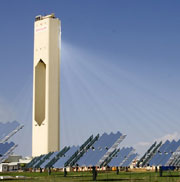India to build world’s biggest solar station near Jaipur
21 Sep 2013
Even as US President Barrack Obama announced major steps to curtail the use of coal for producing electricity, the Indian government on Friday announced that it will build the world's biggest solar power project with a capacity of 4,000 MW in Rajasthan.
 The project will be built on 23,000 acres of land belonging to Sambhar Salts Ltd, a subsidiary of the union government-run Hindustan Salts Ltd under the department of heavy industries, some 75 km from Jaipur.
The project will be built on 23,000 acres of land belonging to Sambhar Salts Ltd, a subsidiary of the union government-run Hindustan Salts Ltd under the department of heavy industries, some 75 km from Jaipur.
The 'Ultra- Mega Green Solar Power Project' is proposed to be located at the Sambar Salts Ltd (SSL) area, close to Sambhar Lake, about 75 km from the state capital Jaipur.
"The department of heavy industry initiated the process of setting up the Sambhar Ultra Mega Green Solar Power Project in the 23,000 acre area of Sambhar Salts Ltd, a subsidiary of Hindustan Salts Ltd, located in Rajasthan," an official release said.
State-run power gear maker Bharat Heavy Electricals Ltd (BHEL) would build the project's first phase of 1,000 MW in a consortium with Solar Energy Corporation, Power Grid Corporation, Satluj Jal Vidyut Nigam (SJVN), and Rajasthan Electronics and Instruments Ltd.
The first phase of the project is to be operational by 2016. Once all the phases are completed, the project would generate 6,000 million units of electricity annually.
The project will supply power to the distribution companies of various states through the national grid.
The project is expected to set a trend for mega-scale solar power development on the lines of the ultra-mega power projects for coal-fired plants that was launched to quickly ramp up generation capacity in the country.
India is working on ways to increase the share of renewable, especially solar, in its total energy basket, but tariff remains an issue. The Jawaharlal Nehru National Solar Mission aims to have about 20,000 MW of grid-connected solar power by 2022.
Based on the experience gained during implementation of the first phase of project, the remaining capacity would be implemented through a variety of models, the statement said.
Being the first project of this scale, the project is expected to set a trend for large scale solar power development in the world.